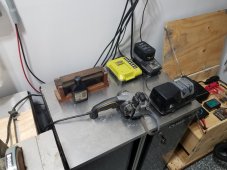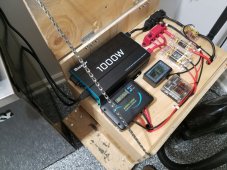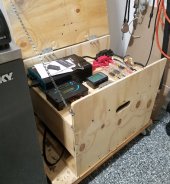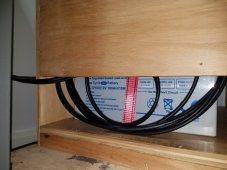What I did over Fall Break
Or
My Solar Emergency System
Or
My Solar Emergency System
Synopsis
- Wanted an emergency power backup system primarily for the freezer to protect the turkey, hog and deer meat.
- Went with Gel batteries, 2 @ 100Ah, because they will not be deep cycled often enough to warrant the cost of WiFeP.
- Installed two 100W mono panels to keep the batteries charged and to cover some light usage.
- Utilized a 1,000W Renogy pure sine wave inverter.
- Did a test run with the Freezer running off the batteries for 6 hours with no problems and meter still said 30hrs left.
- Have it on a portable platform in my work room where it will run the other battery chargers and the occasional use of the belt sander and grinder.
- Cost before rebate, $1,430. After rebate, 1001.22
The Long War Story
I research and planned a solar system trying to save money on my electric bill. As many have discovered, with my limited solar exposure it was a no win for my situation. After much discussion with the CFO and co-CEO of our family we put a dollar amount on the remaining benefits of solar.
- Environmental bragging rights $5
- Tinkering/Experimenting $250
- Emergency Backup $1,000
- The primary usage during a power outage would be to save the frozen foods in the freezer and refrigerator. Analysis shows the new freezer draws 500Wh each day. Obviously during prolonged outage we’d minimize the times we open the doors and turn the temperature up a little.
- Given that this is not a daily, off-grid usage but strictly for power outages and maybe occasional portable usage, Gel cells were selected to save money. Deep cycles, space and weight are not a primary concern.
- The house and lot don’t have a good southern exposure but two typical PV cells can be mounted on an odd, south facing roof extension by the garage, giving 3-4 hours of sun a day. As an emergency system designed only to provide short term coverage, the cells should be adequate to keep the batteries topped off. If, per chance there is an extended outage then the cells would help stretch the power coverage.
Here’s the initial concept diagram.
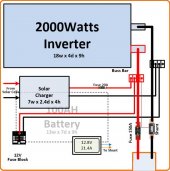
The initial drawing was for a 2,000W inverter, but after analyzing the need further I’ve down sized it to a 1,000W model. Also added a separate fuse block for connecting other devices. Since I’m a ham radio operator and all my radios operate off 12V I thought having a distro would be handy, for participating in portable operations such as ARRL Field Day.
Below is the list of materials. I order most of the Renogy products through Home Depot and had it delivered to the store. That way if anything was damage in shipment I could affect an immediate return and refund on the spot. Most everything else was ordered off of Amazon.
2ea Weize Gel 100Ah Batteries
1ea Renogy 1,000W Inverter
1ea Renogy 500A battery meter
2ea Renogy 100W Mono panel
1ea Renogy 30A PWM Charge Controller
1ea Renogy PV panel Accessory kit
1ea A/C Battery Charger
3ea ANL Fuse Blocks w/ 100A fuses
2ea 30A ANL fuse
2ea 20A ANL fuse
1ea Fuse block with 6 blade fuse circuits
4pr 5/16”-4AWG connector pack
1ea Cable Crimping tool 8AWG-1/0
3ea Black/Red Pair 1’ 4AWG cables with lugs
1ea Plywood DIY enclosure
2ea Mini Tie-down straps
5ft 10AWG wire with 5/16” lugs
100ft 12AWG Solar extension cord.
6pr Solar MC4 Connectors
1ea 14, 12, 10AWG crimping tool
4pr 3/8”-4AWG lugs
The box design initially had the component on a vertical panel extending upward from the battery box. I realized this would somewhat unwieldy trying to put it into a vehicle for portable operation. I then made a two shelf design.
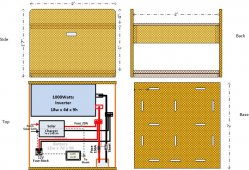
Two by two feet might be a little hard to get into the back seat of a vehicle and even into some boots/trunks, so I experimented with downsizing it to 24”w x 16”d x 16”h. This makes it more portable. I built a 9” tall stand (table) to bring the box up off the floor and I happened to have a flat dolly of perfect dimension to hold the box should I want to move it around.
Here’s a picture of the components while I planned the layout. I could have gone with min-ANL fuse blocks to protect the PV Charge Controller and the 12V distro block but the ANL fuse blocks came in a package of 3.
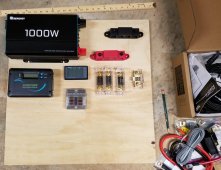 e
eIn the final design thecabinet size is 16”h x 23”w. You can see the final assembly of the electronics shelf in the background. I hate cutting out keyholes so there are only three in the bottom which will allow me to strap up to three batteries down. Below is the final assembly, and yes there are handholds for lifting, though at 150# one’s not likely to do it by oneself. The electronics shelf is NOT attached but sits on the side rails. This allows easy access to the batteries and prevents any attempt to lift the box by the top shelf.
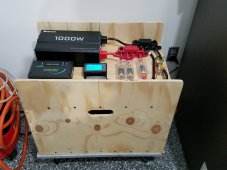
And how’s it working? First I topped off the new batteries with the A/C Charger. Then ran the Freezer for 6 hours off the Inverter. I was surprise, don’t know why but I was, by how quiet it ran. It was 100W off a 1,000W inverter so the fans didn’t even come on. I guess I was expecting some grunting and groaning of which there was none. After six hours the meter said I still had over 30 hours left. I know it’s an educated guess by the meter and I also know that this time will vary by ambient temperature.
My next experiment was to plug in the 40V A/C charger for my Ryobi power tools and charge a nearly dead 6Ah battery. It took more power than I would have guess but of course was handled easily by the setup. Then, due to whatever demons possessed me, I plugged in my 1-1/2hp air compressor, mainly because it was sitting right next to the rig. Shocked I was to look over and see the meter indicate a 98A draw. That exceeds the nominal capacity of the Inverter. (Shades of Star Trek ran through my mind as I could hear Scotty saying, “we’re at 110% now, Captain.”) I only let it run for about 30 seconds when I realized that as the pressure in the air tank increase the motor would have to work harder and draw more current. Then, in hindsight, I checked the specs on the compressor…. (wait for it)…. 1,440W!
The panels finally came in and I mounted them on my little roof. Ran 12AWG extension cables to the work room through the roof top vent. Of course during my first real day of operation it was overcast, but now that there’s full sunlight we’re charging quite well. The thing about winter is that while the sun is lower on the horizon and there are trees in the way, those trees have all lost their leaves so the effect is minimal on the cells.
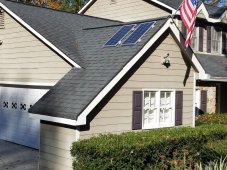
Because I didn’t have an initial intent of adding cells to this system, I mounted as I did, but as soon as I was finished and put the ladder away the CFO says, “We need more solar panels.” Two mistakes were made. First not putting the panels closer together which would have allowed for two more cells on the same row. And secondly, I have the cable-junction on top. If two more cells are added below the existing two it would be easier if all the cables were in closer proximity. This is easily fixed in the future.
Lessons learned
The Renogy Meter was not designed to be surface mounted. I had to fashion a mount out of a plastic utility box for it.
The Renogy Charger controller does come with a surface mount, but it needed a slight modification to be practical. I cut away the individual cable slots on its box so the controller could be more easily lifted out of the mount for securing the cables.
Having a real crimper designed for the application is a necessity. I could never have crimped the 4AWG lugs with my small pliers-type crimper and they wouldn’t have been very secure if I did. I also destroyed my first MC4 connector and the second connector pulled loose with the first tug. The two crimpers I purchased were a very good investment and I wish I had bought them years ago for other projects.
Plan for future expansion even if you don’t think you’ll need it. Mount the panels as if you’re going to add more later and allow room on the electronics area for adding other devices or upgrades to a bigger inverter or charger.
Though I knew the dimensions, the various components were bigger than I had imagined, so leave extra space.
It is so eerily quiet when in operation. I had expected at least a little humming, grunting or groaning. But then remember I grew up in the era of dynamotor power supplies.
More panels and more uses will be added over time. The outside security lights, the workroom lights, my ham radio station and other utility functions.




